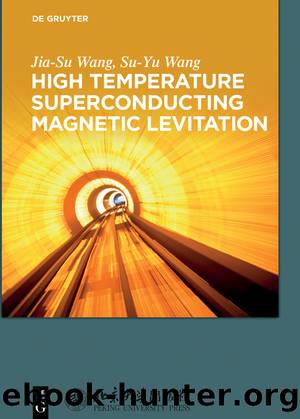High Temperature Superconducting Magnetic Levitation by Jia-Su Wang Su-Yu Wang

Author:Jia-Su Wang,Su-Yu Wang
Language: eng
Format: epub
Publisher: De Gruyter
Published: 2018-08-15T00:00:00+00:00
*Diagonal length, **side length, ***side to side, F 15 (N) is the levitation force of gap of 15 mm.
Song et al. [41] proved experimentally the correctness of this choice. He measured the levitation forces of cylindrical and rectangular shaped HTS YBCO bulks over the PMG (see Section 6.14) using the HTS Maglev measurement system SCMI-01 (see Section 5.3). The average force densities (AFD) were calculated and compared. The melt-textured single-domain YBCO cylinder bulk Beijing 207 (17 × 𝜙30 mm) was fabricated by the Beijing General Research Institute for Nonferrous Metals. Another rectangular bulk TG 208-7 (30 × 35.6 × 15.5 mm) was made by IFW. In all the experiments, the c-axis of the HTS bulk was oriented perpendicular to the surface of the PMG.
The actual vehicle “Century” was designed based on the above measurement results. For the full-scale HTS Maglev vehicle “Century”, 43 pieces of cylindrical YBCO bulks were used in each rectangular-shaped on-board the HTS Maglev equipment (see Section 6.15) in ASCLab. The inside size of the liquid nitrogen vessel equipment was 102 mm wide, 470 mm long, and 168 mm high. The levitation forces of two HTS Maglev vessels composed of rectangular and cylindrical bulks were calculated. The results indicated that an asymmetric field applied about the axes of bulks had more of an effect on the average force density of the rectangular bulk than on the cylindrical bulk. Particularly for the full-scale HTS Maglev vehicle “Century”, the total levitation force was increased from 1092N to 1282N at a gap of 20 mm, if a rectangular bulk was employed rather than cylindrical bulk. Arranging rectangular bulks rather than cylindrical bulks in the same vessel equipment increased the number of YBCO bulks, thus strengthened the levitation force to 1320Nat a gap of 20 mm [41]. These measured data had great significance for practical application. The conclusion of this experiment study has also been used in subsequent development of the HTS Maglev vehicle.
Download
This site does not store any files on its server. We only index and link to content provided by other sites. Please contact the content providers to delete copyright contents if any and email us, we'll remove relevant links or contents immediately.
The Complete Stick Figure Physics Tutorials by Allen Sarah(7264)
Secrets of Antigravity Propulsion: Tesla, UFOs, and Classified Aerospace Technology by Ph.D. Paul A. Laviolette(5237)
Thing Explainer by Randall Munroe(3849)
The River of Consciousness by Oliver Sacks(3498)
The Order of Time by Carlo Rovelli(3097)
How To by Randall Munroe(2969)
A Brief History of Time by Stephen Hawking(2911)
I Live in the Future & Here's How It Works by Nick Bilton(2900)
The Great Unknown by Marcus du Sautoy(2612)
What If?: Serious Scientific Answers to Absurd Hypothetical Questions by Randall Munroe(2589)
Midnight in Chernobyl by Adam Higginbotham(2432)
Blockchain: Ultimate Step By Step Guide To Understanding Blockchain Technology, Bitcoin Creation, and the future of Money (Novice to Expert) by Keizer Söze(2409)
Networks: An Introduction by Newman Mark(2304)
The Meaning of it All by Richard Feynman(2268)
Easy Electronics by Charles Platt(2252)
The Tao of Physics by Fritjof Capra(2204)
Midnight in Chernobyl: The Untold Story of the World's Greatest Nuclear Disaster by Adam Higginbotham(2126)
When by Daniel H Pink(2057)
Introducing Relativity by Bruce Bassett(2048)
